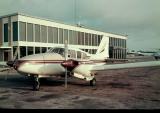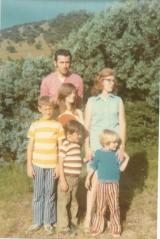Working at the Hobby-Eberly Telescope (HET) was one of the high points of my career in optics, and a time I will never forget! I was employed as the On-site Optical Engineer for the HET scope from about August 2001 until March 2003. From the very start, it was an unusual experience.
Memories
Explore Memories
2010s
2000s
1990s
1980s
1970s
1960s
1950s
1940s
1930s
Visitors
Teachers
UT astronomers
Visiting astronomers
McDonald staff members
My Experiences at the HET
Shared by McDonald staff member Tony Distasio on September 22, 2013
Betty Evans, Dr. David S. Evans
Shared by McDonald staff member Coyne Gibson on September 21, 2013
This morning, I had the unique, and wonderful opportunity to host Ms. Betty Evans, and her niece, for a VIP tour here at McDonald. Ms. Evans is the wife of Dr. David S. Evans, a renowned astronomer from Cambridge, who later worked with McDonald Observatory.
The Astronomy Department Airline: Nonstop Service Between Austin and Marfa

Shared by McDonald staff member Tom Montemayor on September 20, 2013
In the '70s, the Department operated a scheduled air charter service between Austin and Marfa. Strictly speaking, the airplane was "leased" and not "chartered." That word is important to the FAA, because leased aircraft (which operate under FAA Part 91) could do things that chartered aircraft (which operate under FAA part 135) could not (at least legally).
My Growing Up Years at The McDonald Observatory

Shared by McDonald staff member Paige (McGarity) Haddock on September 20, 2013
The McDonald Observatory was my childhood home. My family moved there from San Antonio in 1968 or so, just after the large telescope was built. My father’s office every day was mostly the 82-inch Telescope. My playground was the mountains ...
Shoemaker-Levy 9 impacts from the 0.9-meter Telescope
Shared by McDonald staff member Earl Green on September 19, 2013
The Shoemaker-Levy 9 impacts on Jupiter occured July 16-22, 1994 as pieces of the object, earlier broken into a "string of pearls" by the immense gravity of Jupiter, one by one impacted Jupiter's upper atmosphere leaving scars in the visible image of Jupiter that were larger in size than the Earth. Had one of these objects hit the Earth it would have been devastating, but thankfully Jupiter had caught them and was absorbing the many blows. Observatories all over the world had plans to view the impacts if they could be seen from Earth, but no one knew if it would be possible.

